Article Information
- HongHuan Cui, YuTao Ma, JianKun Liu, ZhiYang Wang . 2017.
- Experimental study of the dynamic behavior of high-grade highway-subgrade soil in a seasonally frozen area
- Sciences in Cold and Arid Regions, 9(3): 289-296
- http://dx.doi.org/10.3724/SP.J.1226.2017.00289
Article History
- Received: November 15, 2016
- Accepted: December 15, 2016
2. School of Civil Engineering, Beijing Jiaotong University, Beijing 100044, China
As an important part of a high-grade highway, the subgrade bears the weight of the wheel load and holds up the pavement structure (Khoury and Zaman, 2004; Chen and Su, 2011). Therefore, under the influence of dynamic load, the intensity and deformation of subgrade soil has a direct effect on the functional performance of a highway. The influence factor is more complicated, especially in a seasonally frozen area (Solanki et al., 2013 ; Salour et al., 2014 ).
As a top-three country with an abundance of frozen soil, China has an area of seasonally frozen ground in north that surpasses half of the national area (Wang, 2011). In these regions, freeze-thaw cycles occur at least once annually (Wu et al., 2015 ). Repeated cycles change the mechanical behavior of the soil (Eigenbrod, 1996). When it freezes, frost heaving happens, owing to water transference (Hermansson and Guthrie, 2005). When it melts, freezing damage phenomena arise, including mud pumping; slope collapse because lower soil doesn't dissolve completely, which results in drainage limitation of upper soil, leading to low loading ability of the subgrade soil (Kweon and Hwang, 2013; Solanki et al., 2013 ). These phenomena influences to some extent the operation and maintenance of a highway under construction (Cui et al., 2015 ). As a result, the research on the effect of freeze-thaw cycles is particularly vital to the mechanical behavior of subgrade soil.
China's highway construction has entered a new era with implementation of a major national strategy for the development of Beijing, Tianjin, and the coordinated region and the successful application of the 2022 Winter Games. At the same time, freeze and thaw of the subgrade in winter and spring will become more and more obvious, with more serious damage caused by the increase of traffic density, use frequency of the roads, and the change of temperature (Konrad and Nixon, 1994). Therefore, a reference for construction and operation should be provided before building a high-grade highway; and it is necessary to study thoroughly the dynamic characteristics and freeze-thaw characteristics of the subgrade soil (He et al., 2010 ).
Study on the mechanical behaviour of soil over freeze-thaw cycles developed earlier, and many achievements have been obtained. The resilient modulus of different fine- and coarse-grained soils was studied by Berg et al. (1996) , who considered that the resilient modulus of the frozen soil was two to three orders of magnitude larger than that of unfrozen soil; however, the resilient modulus of unfrozen soil was affected by water content and type of soil. Chang et al. (2014) studied the influence of freeze-thaw cycles on mechanical properties of Qinghat-Tibet silty sand, finding that freeze-thaw cycles have relatively large influence on mechanical properties of silty sand; and the static strength, elastic modulus, and shear strength parameters reach the minimum value after 7~9 freeze-thaw cycles.
In recent years, the dynamic behavior of soil under freeze-thaw cycles has been studied by more and more scholars with the rapid development of high-grade highways and high-speed railways in seasonally frozen areas. After a large number of dynamic triaxial tests of subgrade soil, Simonsen and Isacsson (2001) found that the influence of confining pressure on the elastic modulus is small. In contrast, the freeze-thaw cycles have great influence on the elastic modulus of the soil. Subsequently, Simonsen (2002) studied by dynamic triaxial tests the resilient modulus of a variety of fine- and coarse-grained subgrade soils under freeze-thaw cycles. Results show that the resilience modulus of the two types of soil reduced in varying degrees after a freeze-thaw cycle. The bearing-plate method was adopted by Wang et al. (2010) , and two different kinds of subgrade soil were tested in a resilient modulus experiment under 0~12 freeze-thaw cycles. It was concluded that soil's modulus of resilience decreases as the number of of freeze-thaw cycles increases, and it tends to be stable after six cycles. Three kinds of subgrade soil of seasonally frozen ground with different plastic limits were chosen by Liu et al. (2011) and processed by triaxial-compression testing under different confining pressure after 0~7 freeze-thaw cycles. According to field-monitoring data, Mao et al. (2014) analyzed the change law on the temperature field and moisture field of subgrade soil of a seasonally frozen area. It was found that the embankment's maximum frozen depth was about one meter, and the variety of moisture content was about 5%~29%. The deformation regulation of the subgrade was acquired through combining laboratory experimentation with numerical simulation.
Due to its sensitivity to temperature and water, fine-grained soil cannot be used directly as roadbed filler. Therefore, freeze resistance and mechanical behavior of soil in which lime (Akoto and Singh, 1986), cement (Parsons and Kneebone, 2004; Wang, 2011), and other materials (Arora and Aydilek, 2005) were added have been researched by some scholars.
At present, as for the change law of static property of high-grade highway-subgrade soil with the number of freeze-thaw cycles, some achievements have been made in related research in China and abroad. However, research on dynamic behavior of subgrade soil is still not very popular, due to the scale of the experiment and the relatively complicated methods involved.
Based on the above analysis, this thesis focuses on the dynamic behavior of high-grade highway-subgrade soil under the influence of freeze-thaw cycles. By the dynamic triaxial test over freeze-thaw cycles, the effect on dynamic strength of subgrade soil under freeze-thaw cycles can be explored; and thus the change law of parameters—including dynamic behavior, dynamic cohesion, and internal friction angle; dynamic elastic modulus of high-grade highway-subgrade soil with the number of freeze-thaw cycles—can be formulated.
2 Experimental designThe subgrade soil of the Chongli-Guyuan section on the Zhangjiakou-Chengde high-speed highway was chosen as the test soil sample. Referring to test methods of soils for highway engineering, we performed the physical properties test; and thereby the soil was recognized as silty clay. Figure 1 shows the distribution curve of the soil's grain size. Table 1 presents basic physical properties of the test soils.
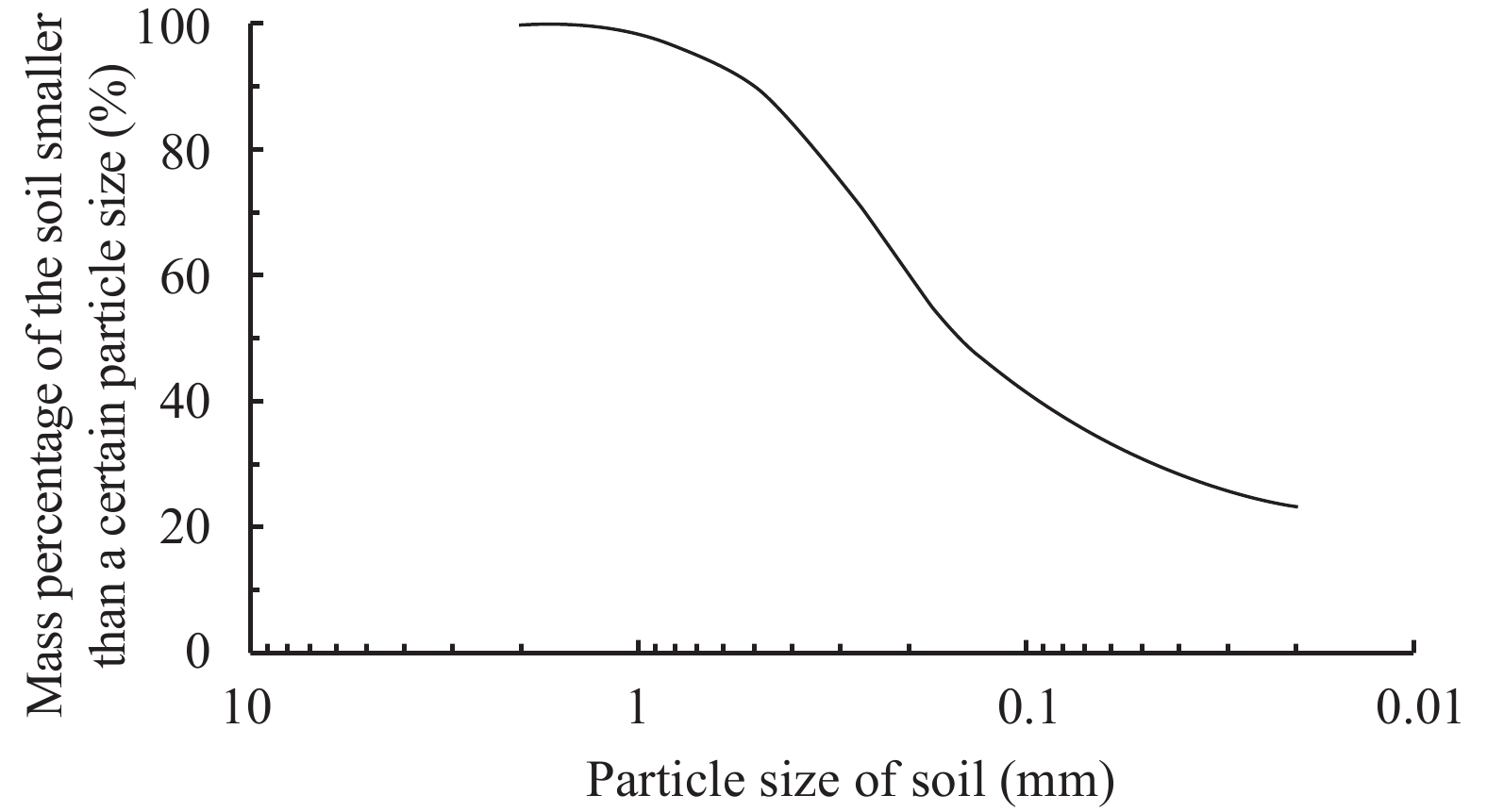
|
| Figure 1 Distribution curve of the soils' grain size |
| wP (%) | wL (%) | IP | Compaction test | |
| w (%) | ρdmax (g/cm3) | |||
| 18 | 31 | 13 | 11 | 1.95 |
The remolded soil was made according to the optimum moisture content of the compaction test, and the soil samples were compacted to a degree of 0.95, as required in "Specifications for Design of Highway Subgrades." The layered compaction method was used to ensure the same degree of compaction and height of the soil samples, with a 39.1-millimeter diameter and an 80-millimeter height. The soil samples prepared were sealed by preservative film and exposed for 24 hours to the freeze-thaw cycles.
Previous studies have shown that the strength and modulus of soil decline evidently after several freeze-thaw cycles. However, the change law of mechanical properties was different with the changes of the temperature of freezing and thawing (Berg et al., 1996 ). According to the temperature environment, the freezing temperature was set to −10 °C and the thawing temperature to 20 °C. To simulate unidirectional freezing of soil, the soil samples were placed on perforated foamed polyethylene board; and their core temperatures were monitored when the external temperature was set to −10 °C and 20 °C. It was found that the internal temperature was the same as the external temperature after 24 hours, so the freezing time and thawing time were set to 24 hours. The board loaded with the soil samples was placed in a low-temperature refrigerator at −10 °C, and it was moved into a standard curing room at 20 °C after 24 hours. When the soil samples were thawed, the whole period was viewed as a complete freeze-thaw cycle.
To explore the effect of freeze-thaw cycles on parameters (including the dynamic strength, dynamic cohesion, and internal friction angle; and dynamic elastic modulus of subgrade soil), soil samples that experienced 0, 1, 3, 5, 7, and 11 freeze-thaw cycles were chosen to perform the dynamic triaxial tests confining pressures of 20, 60, and 100 kPa; the TAJ-20 static and dynamic triaxial testing machine with electrohydraulic servo loading system was used as the test instrument. Taking practical load carrying of subgrade soil into account, the stress-controlled, one-way cyclic load was adopted in the study; and the loading waves were half-sine wave, with frequency of 1 Hz. The dynamic failure criterion was set to 5%, as relevant information required. The axial pressures were adjusted to the same value with confining pressures before cyclic loaded and the drain valve was closed when soil samples were consolidated for 24 hours. Then σd/2 deviator stresses were exerted under undrained conditions, and half-sine waves with dynamic stress amplitude of σd were exerted for dynamic loading following. Figure 2 presents the dynamic triaxial test apparatus; Figure 3 presents theoretical curves of a one-way cyclic load.
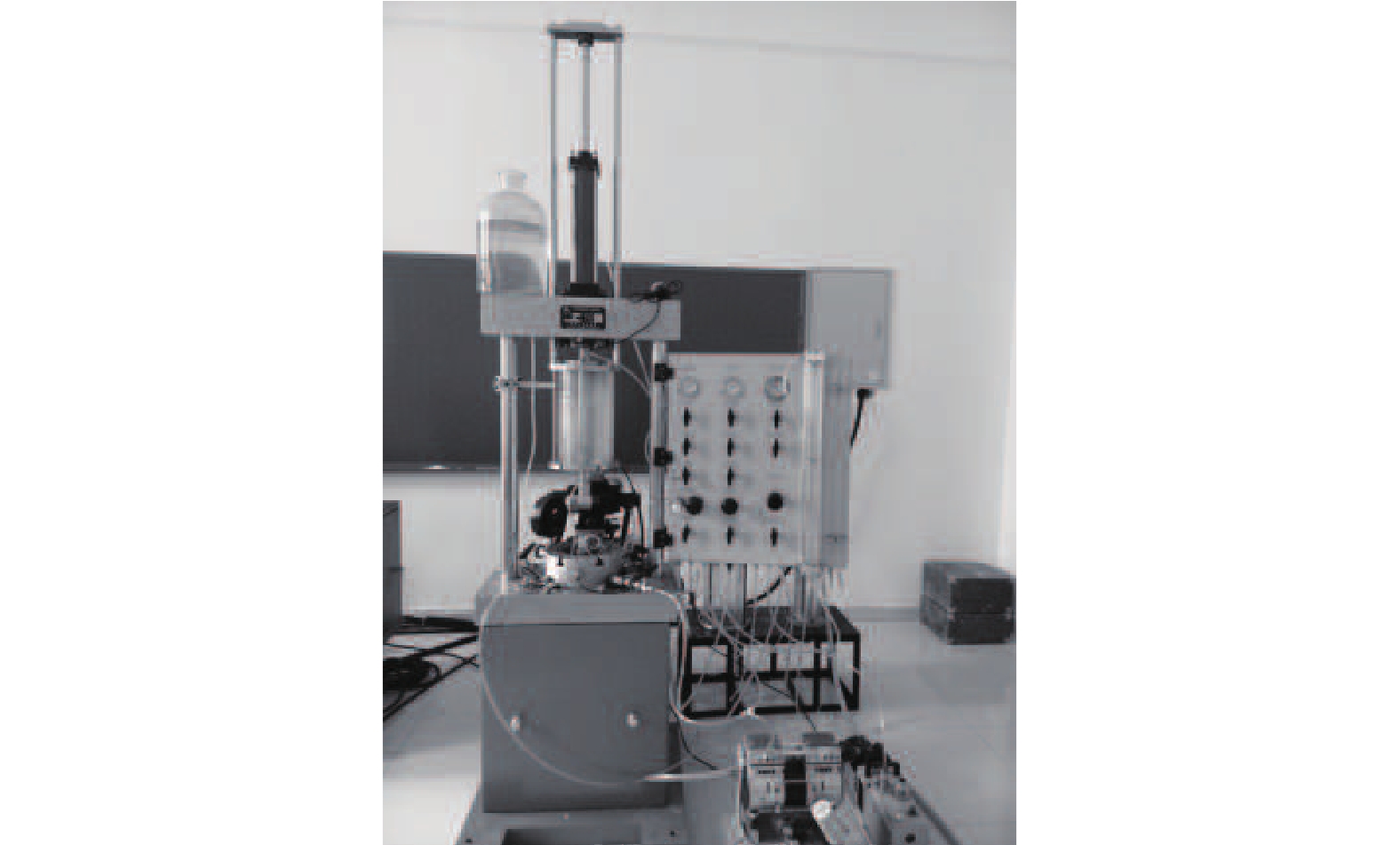
|
| Figure 2 Dynamic triaxial test apparatus |
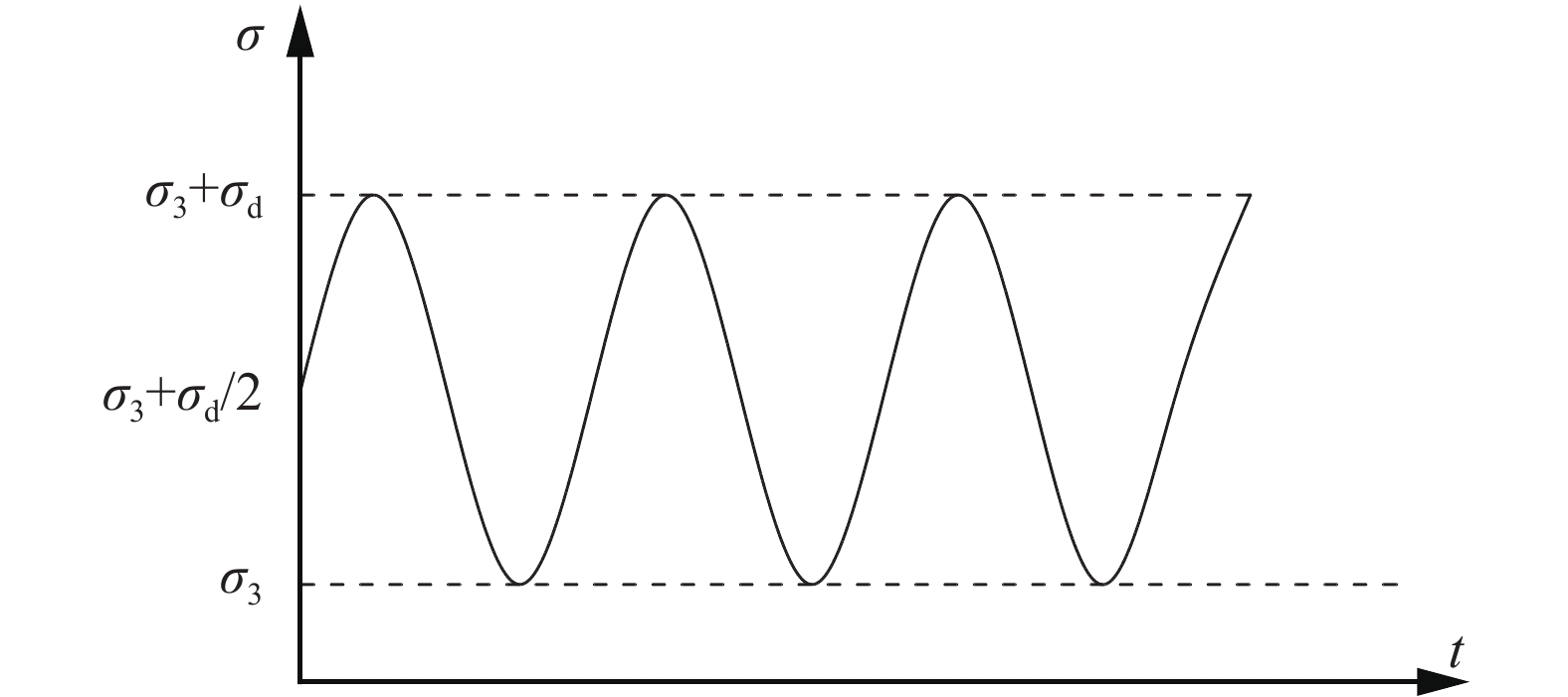
|
| Figure 3 Theoretical curves of a one-way cyclic load |
Under the condition a confining pressure of 20, 60, and 100 kPa, the samples at ambient temperature and subjected to 1, 3, 5, 7, and 11 freeze-thaw cycles were chosen for the dynamic triaxial test. After the dynamic triaxial test, according to processed data, the change law of all parameters with change of of the number of freeze-thaw cycles was drawn. Thus, the effect on the dynamic behavior of the soil under freeze-thaw cycles could be analyzed.
3.1 Effect of dynamic strength under freeze-thaw cyclesAfter isotropic consolidation, samples with different numbers of freeze-thaw cycles NT were subjected to different dynamic stress amplitude σd. According to existing dynamic failure criterion, each sample's vibration number of failure Nf could be identified. Here, σd/2 is a soil's dynamic strength. Then, the dynamic strength curve was available to be drawn, with the horizontal axis lgNf and the vertical axis σd/2. Table 2 illustrates experimental results under 20, 60, and 100 kPa confining pressure. Figure 4 presents the dynamic strength curve of a soil after different numbers of freeze-thaw cycles under three levels of confining pressure.
| NT (times) | σ3 (kPa) | |||||
| 20 | 60 | 100 | ||||
| σd (kPa) | Nf (times) | σd (kPa) | Nf (times) | σd (kPa) | Nf (times) | |
| 0 | 160 | 5,230 | 210 | 14,370 | 255 | 49,936 |
| 190 | 96 | 230 | 184 | 270 | 175 | |
| 200 | 29 | 260 | 35 | 300 | 55 | |
| 1 | 140 | 43,680 | 160 | 25,367 | 220 | 18,632 |
| 165 | 174 | 190 | 642 | 235 | 236 | |
| 180 | 17 | 210 | 62 | 260 | 26 | |
| 3 | 120 | 12,300 | 145 | 48,960 | 200 | 26,800 |
| 140 | 62 | 165 | 595 | 210 | 420 | |
| 150 | 12 | 180 | 85 | 245 | 21 | |
| 5 | 115 | 18,006 | 130 | 16,832 | 190 | 35,420 |
| 120 | 380 | 140 | 3,800 | 200 | 1,104 | |
| 140 | 21 | 170 | 102 | 215 | 75 | |
| 7 | 115 | 18,960 | 125 | 12,786 | 185 | 27,338 |
| 120 | 345 | 140 | 3,980 | 190 | 6,720 | |
| 140 | 34 | 170 | 67 | 205 | 202 | |
| 11 | 110 | 11,000 | 125 | 10,843 | 185 | 16,830 |
| 125 | 96 | 140 | 2,086 | 190 | 1,086 | |
| 130 | 32 | 160 | 230 | 210 | 93 | |

|
| Figure 4 Dynamic strength curves of different confining pressures |
It can be perceived that the dynamic strength of samples after freeze-thaw cycles declines obviously under the same Nf (Figure 4), and its loss amount accounts for 60%~70% of the total loss after three freeze-thaw cycles. After five to seven freeze-thaw cycles, dynamic strength basically tends to be stable. With confining pressure σ3 increasing, a soil's dynamic strength starts to increase and gradually be in sharp growth. Taking three freeze-thaw cycles for an example, we find that the dynamic strength increases by 20% or so when σ3 increases from 20 kPa to 60 kPa and by about 35% when σ3 increases from 60 kPa to 100 kPa (Table 2). The change trend of dynamic strength with other numbers of freeze-thaw cycles NT is basically in accordance with the above. Therefore, details are not repeated here.
3.2 Effect of dynamic cohesion and internal friction angle over freeze-thaw cyclesThree conditions were selected in this section, which means that values for the vibration number of failure Nf were 100, 1,000, and 10,000, respectively. By examining the dynamic strength curve, we can identify the corresponding dynamic stress amplitude σd; and then the dynamic strength failure envelopes can be drafted. According to dynamic strength failure envelopes, dynamic cohesion cd and internal friction angle φd and can be reached. Table 3 shows dynamic cohesion cd and internal friction angle φd under different conditions. Figure 5 presents the relation curves of the dynamic strength index cd, φd, and the number of freeze-thaw cycles NT.
| NT (times) | Nf (times) | |||||||
| 100 | 1,000 | 10,000 | ||||||
| φd (°) | cd (kPa) | φd (°) | cd (kPa) | φd (°) | cd (kPa) | |||
| 0 | 31.55 | 95.57 | 31.96 | 84.26 | 34.23 | 69.68 | ||
| 1 | 28.71 | 89.39 | 28.15 | 81.10 | 27.21 | 72.36 | ||
| 3 | 31.38 | 64.36 | 29.47 | 61.76 | 29.95 | 55.05 | ||
| 5 | 29.53 | 65.85 | 28.35 | 59.71 | 27.54 | 53.06 | ||
| 7 | 30.99 | 59.50 | 30.46 | 52.49 | 28.48 | 50.92 | ||
| 11 | 31.01 | 58.88 | 28.36 | 56.58 | 27.80 | 49.62 | ||

|
| Figure 5 Relation curves of dynamic strength index φd, cd, and number of freeze-thaw cycles NT |
It is concluded that with NT increasing, φd fluctuates within a certain range and tends to decline; but the regularity is not obvious (Figure 5). With Nf increasing, φd decreases; and a downward trend is no longer apparent. When Nf increases from 100 cycles to 1,000 cycles, φd declines by about 2%~6%. However, when Nf increases from 1,000 cycles to 10,000 cycles, it declines by only 1%~2% (Table 3).
With NT increasing, cd declines obviously (Figure 5), by 20%~40% or so after seven freeze-thaw cycles and then tends to be stable (Table 3). With Nf increasing, cd decreases; and the downward trend is basically unchanged.
3.3 Effect of dynamic elastic modulus over freeze-thaw cyclesAfter the dynamic triaxial test, the tenth cycles of the σd-εd curve were selected as hysteresis loops; then the ellipse-fitting method was used to calculate the slope of the line between the vertex and endpoint, which was the dynamic elastic modulus under present dynamic stress. That means Ed=σd/εd. See Figure 6.
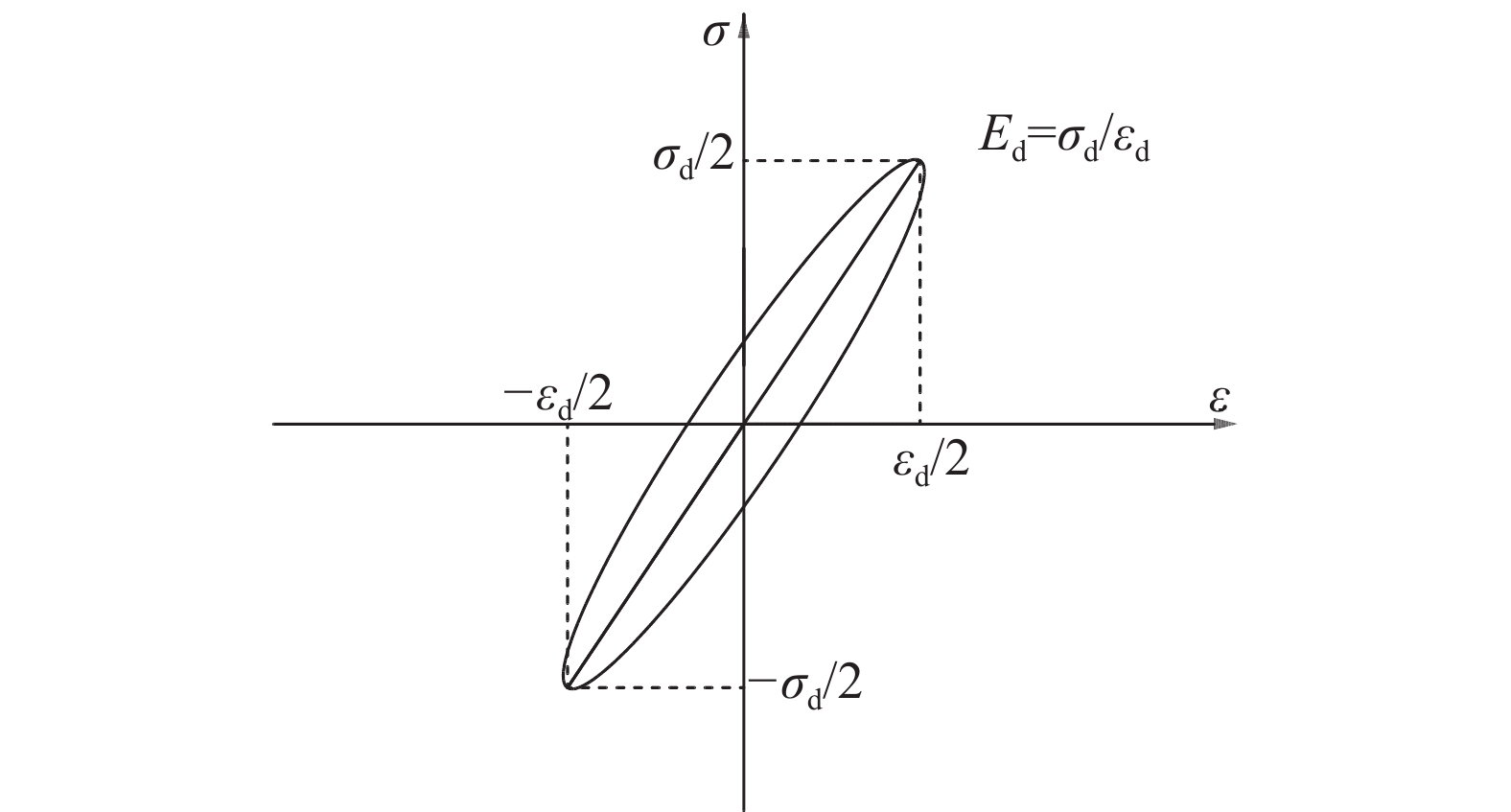
|
| Figure 6 The method for determining dynamic elastic modulus Ed |
Recent research demonstrates that the dynamic constitutive of soil under cyclic loading is in accordance with the following hyperbolic relationship (Chen and Li, 2011; Wang, 2013):
| ${\sigma _d} = \frac{{{\varepsilon _d}}}{{a + b{\varepsilon _d}}}$ | (1) |
σd is dynamic stress amplitude, εd is dynamic strain, a, b are the parameters about soil property. Furthermore, the following equation is derived from (1):
| ${E_d} = \frac{{{\sigma _d}}}{{{\varepsilon _d}}} = \frac{1}{{a + b{\varepsilon _d}}}$ | (2) |
It is concluded that a, b value under different conditions can be acquired by linear fitting processing to 1/Ed. Then, maximum dynamic elastic modulus Ed max will be certain. That means Ed max=1/a. Figure 7 shows the relationship between dynamic elastic modulus Ed and dynamic strain εd under three confining pressures. Table 4 shows soil's a, b value and Ed max under different numbers of freeze-thaw cycles NT. Figure 8 presents the change of Ed max with vibration number of failure Nf.
Under the same confining pressure and number of freeze-thaw cycles, a sample's decrement degree of dynamic elasticity modulus Ed is higher when dynamic strain εd is small. With εd increasing, that decrement degree becomes smaller. Under the same sample's εd, with the number of freeze-thaw cycles increasing, all Ed under different confining pressure tend to decline. After five freeze-thaw cycles, the decrement degree of Ed reaches 30%~40%; and then it basically tends to be stable. With confining pressure increasing, a sample's Ed under different numbers of freeze-thaw cycles increases without exception; and it is more obvious when dynamic strain is smaller (Figure 7).
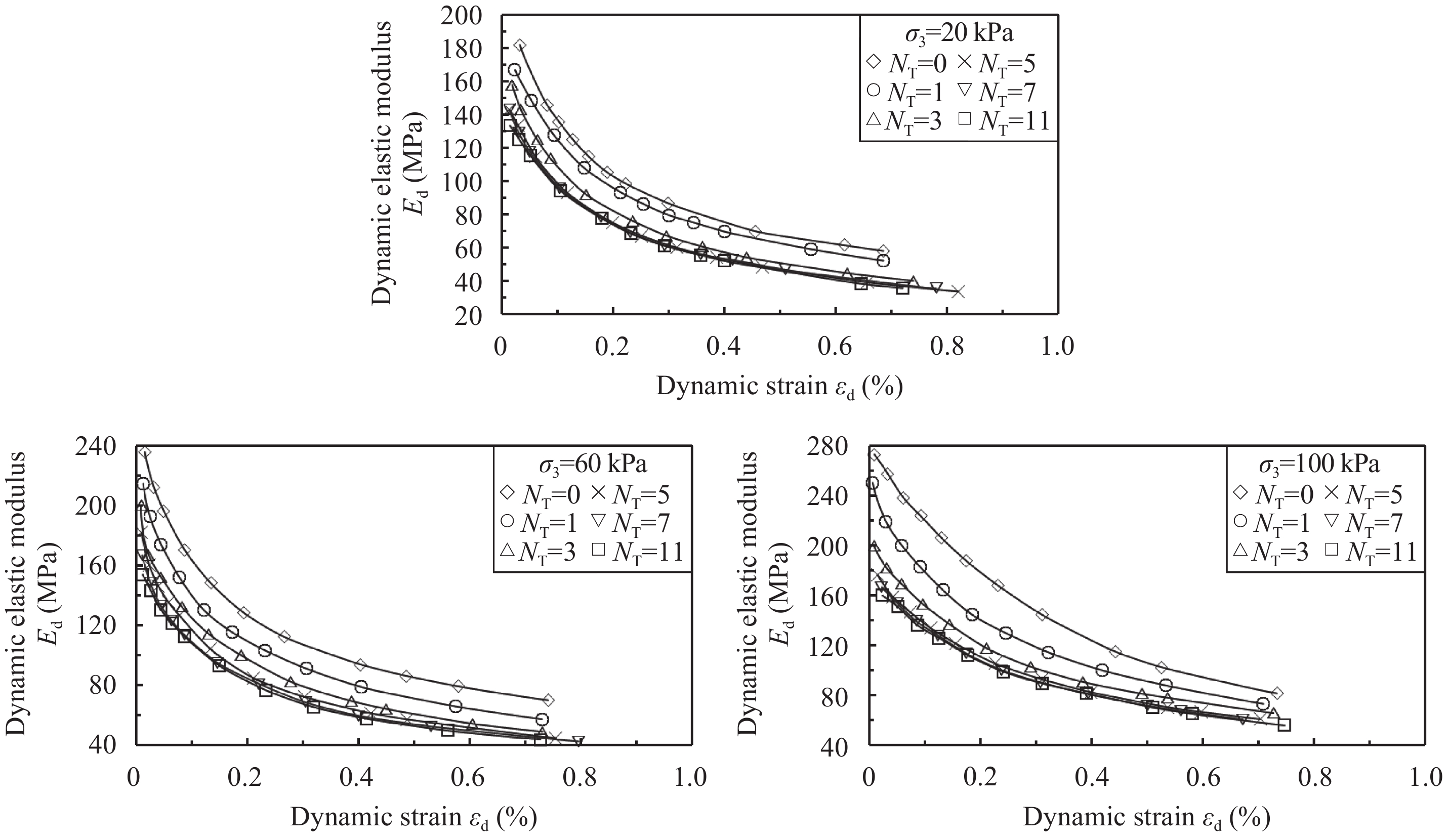
|
| Figure 7 Relation curves of dynamic elastic modulus Ed and dynamic strain εd |
| NT (times) | σ3 (kPa) | ||||||||||
| 20 | 60 | 100 | |||||||||
| a | b | Ed max | a | b | Ed max | a | b | Ed max | |||
| 0 | 0.0174 | 0.0058 | 172.414 | 0.0138 | 0.0046 | 217.391 | 0.0120 | 0.0034 | 294.118 | ||
| 1 | 0.0196 | 0.0061 | 163.934 | 0.0175 | 0.0052 | 192.308 | 0.0135 | 0.0042 | 238.095 | ||
| 3 | 0.0255 | 0.0066 | 151.515 | 0.0210 | 0.0057 | 175.439 | 0.0142 | 0.0052 | 192.308 | ||
| 5 | 0.0276 | 0.0073 | 136.986 | 0.0223 | 0.0062 | 161.290 | 0.0155 | 0.0057 | 175.439 | ||
| 7 | 0.0272 | 0.0075 | 133.333 | 0.0224 | 0.0068 | 147.059 | 0.0160 | 0.0058 | 172.414 | ||
| 11 | 0.0287 | 0.0074 | 135.135 | 0.0233 | 0.0069 | 144.928 | 0.0160 | 0.0060 | 166.667 | ||
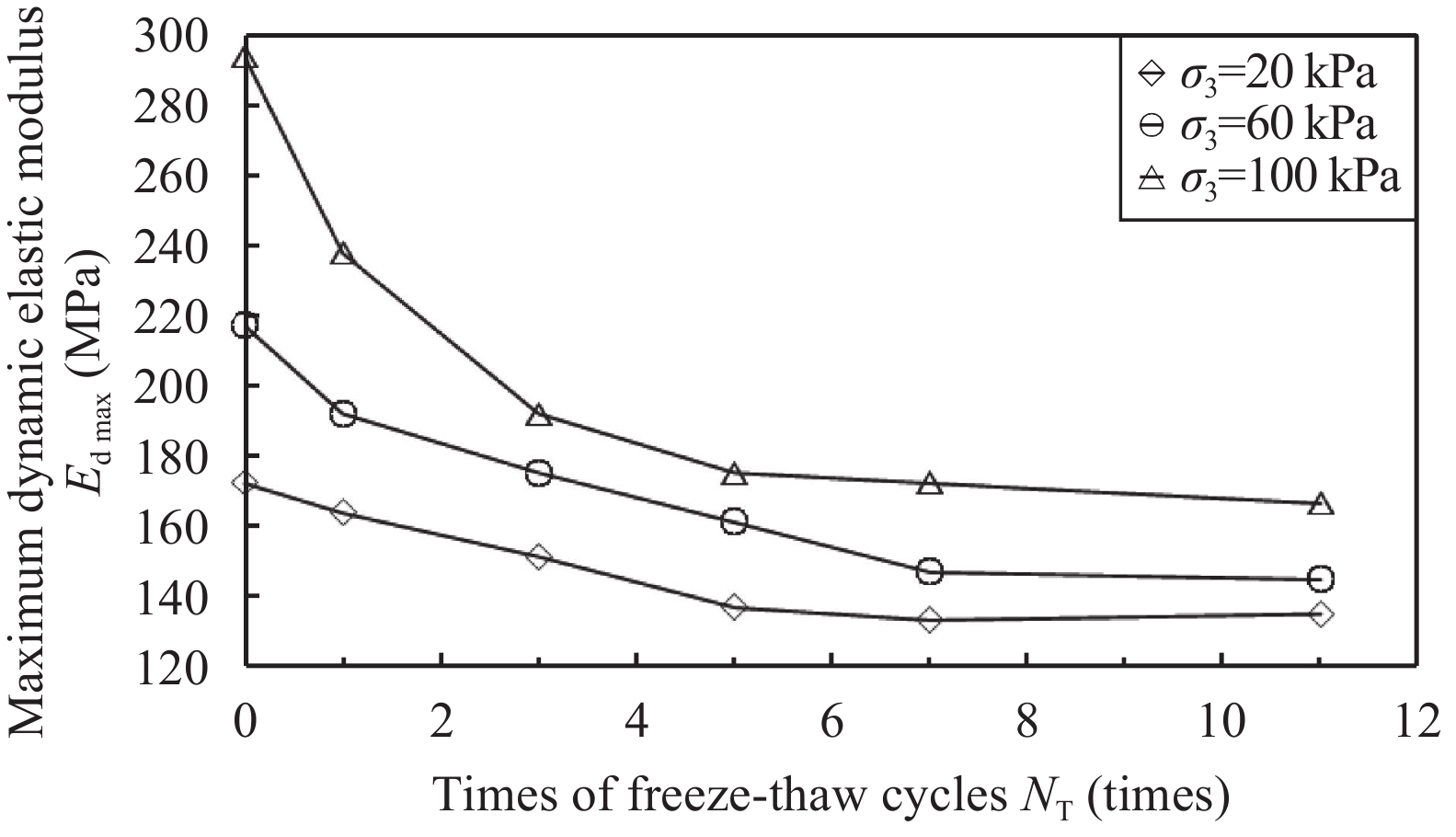
|
| Figure 8 Relation curves of maximum dynamic elastic modulus Ed max and number of freeze-thaw cycles NT |
With the number of freeze-thaw cycles increasing, Ed max under different confining pressures declines obviously (Figure 8), by 20%~40% after five cycles and then basically tending to be stable. With the confining pressure increasing, sample's Ed max declines; and the downward trend is basically identical (Table 4).
4 DiscussionThere are now few studies on the basic dynamic strength of subgrade silty clay and the variation of dynamic strength and dynamic modulus over freeze-thaw cycles. In these circumstances, reference should be provided by the exploration of the strength and deformation of subgrade silty clay in a seasonally frozen area and the analysis about the influence of freeze-thaw cycles on soil (Hermansson and Guthrie, 2005).
Aiming at the change law of parameters (including dynamic strength and dynamic cohesion), it can be concluded that after freeze-thaw cycles, a soil's internal structure changes; and with the number of the freeze-thaw cycles increasing, the pores of the soil expands, which results in elimination of the force among soil particles. What's more, the soil's dynamic strength declines as well. After five to seven freeze-thaw cycles, the void ratio gradually tends to stabilize; and the loss of dynamic strength basically reaches the maximum value. With the confining pressure increasing, the pores that were enlarged after freeze-thaw cycles were squeezed; and then the force among soil particles increases. After that, soil's dynamic strength also increases.
Aiming at the change law of dynamic elastic modulus, it is deduced that under the same confining pressure and number of freeze-thaw cycles, a sample is at the elastic stage when dynamic strain is small. With the strain value increasing, a sample's decrement degree of dynamic elastic modulus increases. Soil gradually enters the elastic plastic stage; and at this stage, the decrement degree becomes smaller. Freeze-thaw cycles change a soil's internal structure and enlarge the space among soil particles. They intensify a sample's plastic deformation process under dynamic loading. After seven freeze-thaw cycles, a soil's internal structure tends to stop changing; and the sample's plastic deformation basically tends to be stable under dynamic loading. With confining pressure increasing, a sample's average consolidation stress augments, which slows down its degree of plastic deformation.
At present, what is researched in this paper is only the effect of freeze-thaw cycles on the dynamic behaviour of subgrade silty clay. It is our intention that a large number of studies will be launched to explore the interaction of other factors and freeze-thaw cycles on subgrade silty clay that conforms to the actual situation of high-grade highway-subgrade soil in seasonally frozen areas.
5 ConclusionsAccording to the dynamic triaxial test over freeze-thaw cycles, the paper takes the subgrade silty clays of the Zhangjiakou region as the study object, explores the effect on dynamic behavior of subgrade silty clays under freeze-thaw cycles, and draws the change law of the parameters (including dynamic strength, dynamic cohesion, and internal friction angle; and dynamic elastic modulus) with the number of freeze-thaw cycles. The conclusions from this experiment condition are as follows:
(1) Dynamic strength tends to decline after freeze-thaw cycles, with a 60%~70% decline after three cycles, and then stabilizes after five to seven cycles.
(2) With the number of freeze-thaw cycles increasing, the internal friction angle fluctuates within a certain range without an obvious change law, only presenting the tendency of dropping off. The dynamic cohesion declines obviously, with about 20%~40% decline after seven freeze-thaw cycles, and then tends to be stable.
(3) With the number of freeze-thaw cycles increasing, the dynamic elastic modulus and maximum dynamic elastic modulus incline to decrease distinctly. After five freeze-thaw cycles, the former declines 30%~40% and then remains stable. Meanwhile, the latter falls 20%~40%.
Acknowledgments:The authors are grateful to the anonymous reviewers for their critical reviews and comments on drafts of this manuscript. This research was funded by the National Natural Science Foundation of China (No. 51378057).
| Akoto BA, Singh G, 1986. Behavior of lime-stabilized laterite under repeated loading. Australian Road Research, 16(4): 259–267. |
| Arora S, Aydilek AH, 2005. Class F Fly-Ash-Amended soils as highway base material. Journal of Materials in Civil Engineering, 17(6): 640–649. DOI: 10.1061/(ASCE)0899-1561(2005)17:6(640) |
| Berg RL, Bigl SR, Stark J, et al., 1996. Resilient modulus testing of materials from MN/ROAD, Phase1. Defects. |
| Chang D, Liu JK, Li X, et al, 2014. Experiment study of effects of freezing-thawing cycles on mechanical properties of Qinghai-Tibet silty sand. Chinese Journal of Rock Mechanics and Engineering, 33(7): 1496–1502. |
| Chen B, Li YG, 2011. Influencing factors on dynamic elastic modulus of lime soil for subgrade. Journal of Underground Space and Engineering, 7(Supp. 1): 1524–1528. |
| Chen J, Su YH, 2011. Numerical simulation of dynamic performance of highway subgrade under traffic loads. Journal of Highway and Transportation Research and Development, 28(5): 44–48. DOI: 10.3969/j.issn.1002-0268.2011.05.009 |
| Cui HH, Liu JK, Zhang LQ, et al, 2015. A constitutive model of subgrade in a seasonally frozen area with considering freeze-thaw cycles. Rock and Soil Mechanics, 36(8): 2228–2236. |
| Eigenbrod KD, 1996. Effects of cyclic freezing and thawing on volume changes and permeabilities of soft fine-grained soils. Canadian Geotechnical Journal, 33(4): 529–537. DOI: 10.1139/t96-079-301 |
| Hermansson A, Guthrie WS, 2005. Frost heave and water uptake rates in silty soil subject to variable water table height during freezing. Cold Regions Science and Technology, 43(3): 128–139. DOI: 10.1016/j.coldregions.2005.03.003 |
| He JK, Niu YF, Liu HB, 2010. Effects of freeze-thaw cycle on physical and mechanical properties of subgrade soil. Engineering & Test, 53(3): 49–52. DOI: 10.3969/j.issn.1674-3407.2013.03.013 |
| Khoury N, Zaman M, 2004. Correlation between resilient modulus, moisture variation, and soil suction for subgrade soils. Transportation Research Record, 1874(1): 99–107. DOI: 10.3141/1874-11 |
| Konrad JM, Nixon JF, 1994. Frost heave characteristics of a clayey silt subjected to small temperature gradients. Cold Regions Science & Technology, 22(3): 299–310. DOI: 10.1016/0165-232X(94)90007-8 |
| Kweon G, Hwang T, 2013. Deformational characteristics of subgrade soils and subbase materials with freeze-thaw. Ksce Journal of Civil Engineering, 17(6): 1317–1322. DOI: 10.1007/s12205-013-0294-0 |
| Liu HB, Wang J, Wei HB, et al, 2011. Correlation of subgrade soil shear strength and plasticity index under freeze-thaw cycles. Journal of Jilin University (Engineering and Technology Edition), 41(2): 150–152. |
| Mao YC, Li GY, Zhang QL, et al, 2014. Research on the moisture and temperature variation of loess roadbed in seasonally frozen ground regions. Journal of Glaciology and Geocryology, 36(4): 1011–1016. |
| Parsons RL, Kneebone E, 2004. Use of cement kiln dust for the stabilization of soils. ASCE Geotechnical Special Publication, 1124–1131. DOI: 10.1139/cgj-38-4-863. |
| Salour F, Erlingsson S, Zapataclaudia E, 2014. Modelling resilient modulus seasonal variation of silty sand subgrade. Canadian Geotechnical Journal, 51(12): 1413–1422. DOI: 10.1139/cgj-2013-0484 |
| Simonsen E, Isacsson U, 2001. Soil behavior during freezing and thawing using variable and constant confining pressure triaxial tests. Canadian Geotechnical Journal, 38(4): 863–875. DOI: 10.1139/t01-007 |
| Simonsen E, Janoo VC, Isacsson U, 2002. Resilient properties of unbound road materials during seasonal frost conditions. Journal of Cold Regions Engineering, 16(1): 28–50. DOI: 10.1061/(ASCE)0887-381X(2002)16:1(28) |
| Solanki P, Zaman M, Khalife R, 2013. Effect of freeze-thaw cycles on performance of stabilized subgrade. Geotechnical Special Publication, 230: 566–580. DOI: 10.1061/9780784412770.038 |
| Wang J, 2013. Experimental study on dynamic elasticity moduluss and damping ratio of coarse-grained soils. M.S. Thesis, Central South University, pp. 23. |
| Wang TL, 2011. Study on dynamic and static properties of cement and lime-modified filllings subjected to freezing and thawing. Ph.D. Thesis, Beijing Jiaotong University, pp. 1. |
| Wang WN, Zhi XL, Mao XS, et al, 2010. Experimental study of resilience modulus of subgrade soil under circles of freezing and thawing. Journal of Glaciology and Geocryology, 32(5): 954–959. |
| Wu LB, Qi W, Niu FJ, et al, 2015. A review of studies on roadbed frozen damage and countermeasures in seasonal frozen ground regions in China. Journal of Glaciology and Geocryology, 37(5): 1283–1293. |
 2017, 9
2017, 9


